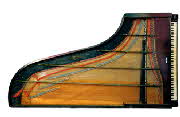|
PIANO CONSERVATION
See also the article in the “Acoustic and Digital Piano Buyer:” Restorative Conservation in Piano Rebuilding http://www.pianobuyer.com/fall10/67.html
It is a fact that while most objects over a century old are often regarded as antiques and receive special care, pianos are usually regarded wholly for their function and have been neglected as historical objects. The field of piano conservation lags behind other conservation fields. This is partly because pianos built after 1860 are often regarded by early piano performance specialists as “modern” and without historical merit, while most pianos built before 1910 are deteriorated, and have less value as musical instruments.
As a student of the early Steinway (1853-1892) I repeatedly find instruments which have recently had their value as documents compromised, often without any significant improvement in their musical usefulness. Retailers and have sent large numbers of these instruments to wholesale refinishers and rebuilders, where polyester and polyurethane finishes are passed off as “french polish.” They have thrown away original actions and soundboards, artifacts critical to the study of the period of piano design and manufacture. This, along with the ‘restorations’ of the manufacturers themselves (especially, ironically, the Steinway company) has resulted in a kind of historical “theft” - making the study of this historical period extremely difficult.
It is time for piano technicians, commercial shops, and manufacturer restoration facilities to exercise balance and restraint when advising on the restoration of pianos older than 100 years. We should expect an increasing knowledge of conservation by these parties, and the increased use of conservators and historical experts for consultation on pianos older than 100 years. Consumers are often more knowledgable than restorers about this, and should require and expect this knowledge.
Robert Barclay’s fine 2004 work “The Care of Historical Musical Instruments” establishes a model for how to approach the care of pianos from this early modern period. “Restorative Conservation” should be carefully studied by all who own or provide service for early modern pianos. Not all antique instruments must be removed from service, but their continued use (“currency:”) should be assessed for the loss to history which could result. Restoration, usually in itself harmful to the historical value of the document, should be practiced following principles of conservation - dramatically reducing or eliminating the loss of the document to organology and history.
Since the early modern period has not been thoroughly studied, the conservation of these instruments is particularly important. Even though these instruments are often built in a commercial manner, rather than as old-world, individually crafted masterpieces more familiar to the conservator, they are as equally important for conservation. The story of the modern piano has, to date, only been told through historical accounts, documents and archival research, and first person accounts. The actual study of the musical instruments themselves will depend for its success on the conservation of those instruments. The story of the early Steinway - not yet told except as business and social history - the stories of Chickering, Mason and Hamlin, Broadwood, Erard, Pleyel - have all been told - except for the most important element - the story the pianos themselves tell when we study them. That story can only be told if there are good original examples. So far the best and earliest historical examples of Steinway pianos have eluded my study - and often because they had just been rebuilt by a commercial rebuilder or the Steinway company itself.
Recently I had the opportunity to advise the owner of an 1875 Steinway 7’2” in nearly original condition. This instrument is now in the care of a conservator, and the owner has committed to non-invasive treatment. The instrument itself is only one of many thousands built by the company of its type, the most commonly built wing grand of the era. But very few of these instruments are in as original condition, and a highly regarded piano technician was set to replace the original action parts. Now the instrument will retain its original condition for posterity.
Learning and respecting historical value, maintaining originality, reversibility of restoration, and stabilizing and removing destructive environmental conditions are principles which should be followed by owners, consultants and service personnel. The role of the conservator, and the obtaining of a treatment report, is critical to the study, and essential to the survival of good historical examples of early modern pianos.
We can provide additional value beyond the conservator’s treatment report because of our own study of the early modern period, especially with our work in documenting historical Steinway pianos. We will refer scientific analysis of finishes to conservators where appropriate, and will practice restorative conservation with historic instruments.
|
